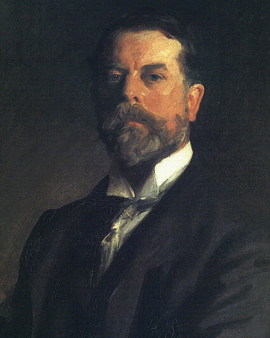Unzählige Skizzen und Kohlezeichnungen, etwa 2000 Aquarelle und 900 Ölgemälde, dies sind nicht etwa die Eckdaten eines bekannten Kunstmuseums, diese Zahlen umschreiben den Umfang des Lebenswerkes von John Singer Sargent. Der am 12. Juli 1856 geborene US-Amerikaner zählt zu den bedeutendsten und gefragtesten US-amerikanischen Portrait Maler seiner Zeit.
Die Kindheit des Künstlers verlief jedoch alles andere als gewöhnlich und ist nicht vergleichbar mit der von anderen namenhaften Maler. Sein Vater war Mediziner für Augenheilkunde und lebte gemeinsam mit seiner Frau und den Kindern in Europa. Aufgrund des seelischen Leidens der Mutter verweilte die Familie allerdings nie länger an einem bestimmten Ort. Sie bereisten den gesamten Kontinent, wobei stets versucht wurde die große Hitze zu meiden. So lebte John Singer Sargent in seiner Kindheit und Jugend unter anderem in Rom, Paris, London, Dresden und Florenz. In den Städten besuchte er immer wieder kurzweilig Kunstschulen und war Schüler einiger bekannter Künstler unter anderem von Carolus-Duran. Durch diese nomadische Lebensweise genoss der junge Sargent allerdings nur wenig formelle Schulbildung auch Freundschaften waren rar. Eine Ausnahme stellt jedoch die Bekanntschaft zu Violet Paget dar. Sie lernte die Familie Sargent in Nizza kennen. Das Portrait der jungen Frau, welches 1881 entstand, zählt als eines der frühsten Werke von John Singer Sargent.
Das Reisen praktisch in die Wiege gelegt, hielt es den talentierten Maler in seinem weiteren Leben nur selten dauerhaft an einem bestimmten Ort. Dies spiegeln auch seine Werke wider. Diese zeigen unter anderem Landschaften und Szenen aus Ägypten, Palästina, Frankreich, Spanien oder Portugal. John Singer Sargents war bekannt und gelobt für seine technischen Fähigkeiten und doch brachte ihm eben diese technische Raffinesse und perfekte Pinselführung immer wieder auch Vorwürfe einer gewisse Oberflächlichkeit ein. Vermutlich in Folge seines freien Lebens löste der Amerikaner 1884 einen wahren Skandal aus. Beim Salon de Paris reichte er das Portrait der Madame X ein. Dieses, zweifelsohne wunderschöne, Gemälde zeigt eine Dame mit gewisser Schulterfreiheit. Eben diese führte zu großen Diskussionen, denn die freizügige nackte Schulter schien für die Pariser Salons nicht zuträglich zu sein. Des Weiteren beteiligte sich Sargent am Widerstand gegen das konservative Kunstverständnis der Royal Academy of Arts und gründete gemeinsam mit anderen Künstler den New English Art Club. Der Maler wurde, vor allem zu Beginn des 20. Jahrhunderts europaweit geschätzt und zählte zu den gefragtesten, aber auch teuersten Portraitmaler seiner Zeit. Seine letzten großen Werke waren unter den Ereignissen des Ersten Weltkrieges entstanden. So zeigte er mit seinem Werk „Gassed“ die britischen Truppen nach dem Gasangriff der deutschen Kräfte. Im Auftrag der National Portrait Gallery fertigte er 1922 ein Gruppenportrait der Generäle des Ersten Weltkrieges. Nur drei Jahre später, am 14. April 1925 starb John Singer Sargent in London.
×





.jpg)
.jpg)
.jpg)
.jpg)
_-_(MeisterDrucke-876369).jpg)
_-_(MeisterDrucke-876369).jpg)
.jpg)
.jpg)
_-_(MeisterDrucke-382442).jpg)
_-_(MeisterDrucke-382442).jpg)
.jpg)
.jpg)
.jpg)
.jpg)
.jpg)
.jpg)
.jpg)
.jpg)
.jpg)
.jpg)
 1883-84 - (MeisterDrucke-135589).jpg)
 1883-84 - (MeisterDrucke-135589).jpg)
.jpg)
.jpg)
.jpg)
.jpg)
.jpg)
.jpg)
.jpg)
.jpg)
.jpg)
.jpg)
.jpg)
.jpg)
.jpg)
.jpg)
.jpg)
.jpg)
_-_(MeisterDrucke-902337).jpg)
_-_(MeisterDrucke-902337).jpg)
_-_(MeisterDrucke-381800).jpg)
_-_(MeisterDrucke-381800).jpg)
.jpg)
.jpg)
_-_(MeisterDrucke-581412).jpg)
_-_(MeisterDrucke-581412).jpg)
.jpg)
.jpg)
.jpg)
.jpg)
.jpg)
.jpg)
.jpg)
.jpg)
.jpg)
.jpg)
 1911 - (MeisterDrucke-124318).jpg)
 1911 - (MeisterDrucke-124318).jpg)
.jpg)
.jpg)
.jpg)
.jpg)
.jpg)
.jpg)
.jpg)
.jpg)
.jpg)
.jpg)
.jpg)
.jpg)
.jpg)
.jpg)
.jpg)
.jpg)
.jpg)
.jpg)
.jpg)
.jpg)
.jpg)
.jpg)
 - (MeisterDrucke-223010).jpg)
 - (MeisterDrucke-223010).jpg)
_1882_-_(MeisterDrucke-381854).jpg)
_1882_-_(MeisterDrucke-381854).jpg)
.jpg)
.jpg)
.jpg)
.jpg)
.jpg)
.jpg)
.jpg)
.jpg)
 - (MeisterDrucke-14384).jpg)
 - (MeisterDrucke-14384).jpg)
_-_(MeisterDrucke-580438).jpg)
_-_(MeisterDrucke-580438).jpg)
.jpg)
.jpg)
 - (MeisterDrucke-136003).jpg)
 - (MeisterDrucke-136003).jpg)
.jpg)
.jpg)
.jpg)
.jpg)
.jpg)
.jpg)
.jpg)
.jpg)
_-_(MeisterDrucke-1093963).jpg)
_-_(MeisterDrucke-1093963).jpg)
.jpg)
.jpg)
.jpg)
.jpg)
_-_(MeisterDrucke-580431).jpg)
_-_(MeisterDrucke-580431).jpg)
.jpg)
.jpg)
.jpg)
.jpg)
.jpg)
.jpg)
.jpg)
.jpg)
.jpg)
.jpg)
.jpg)
.jpg)
_-_(MeisterDrucke-588102).jpg)
_-_(MeisterDrucke-588102).jpg)
.jpg)
.jpg)
.jpg)
.jpg)
.jpg)
.jpg)
.jpg)
.jpg)
.jpg)
.jpg)
.jpg)
.jpg)
 - (MeisterDrucke-124337).jpg)
 - (MeisterDrucke-124337).jpg)
.jpg)
.jpg)
.jpg)
.jpg)
.jpg)
.jpg)
_-_(MeisterDrucke-383957).jpg)
_-_(MeisterDrucke-383957).jpg)
.jpg)
.jpg)
.jpg)
.jpg)
![Studies of Male Nudes [verso], 1918-1919 by John Singer Sargent Studies of Male Nudes [verso], 1918-1919 by John Singer Sargent](/kunstwerke/300px/John_Singer_Sargent_-_Studies_of_Male_Nudes_verso_1918-1919_-_(MeisterDrucke-1160238).jpg)
![Studies of Male Nudes [verso], 1918-1919 by John Singer Sargent](/kunstwerke/400w/John_Singer_Sargent_-_Studies_of_Male_Nudes_verso_1918-1919_-_(MeisterDrucke-1160238).jpg)
.jpg)
.jpg)
.jpg)
.jpg)
.jpg)
.jpg)
.jpg)
.jpg)
.jpg)
.jpg)
.jpg)
.jpg)
.jpg)
.jpg)
.jpg)
.jpg)
_-_(MeisterDrucke-951706).jpg)
_-_(MeisterDrucke-951706).jpg)
.jpg)
.jpg)
.jpg)
.jpg)
.jpg)
.jpg)
.jpg)
.jpg)
.jpg)
.jpg)
.jpg)
.jpg)
.jpg)
.jpg)
.jpg)
.jpg)
.jpg)
.jpg)
.jpg)
.jpg)
.jpg)
.jpg)
.jpg)
.jpg)






